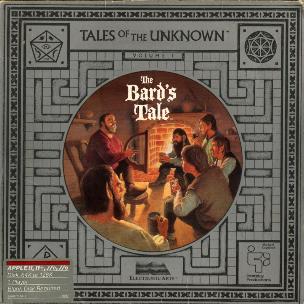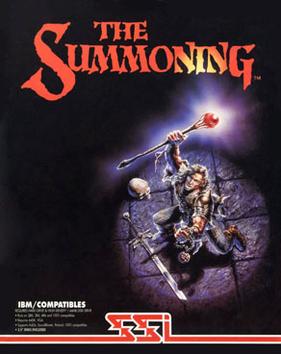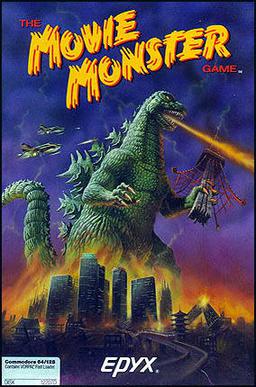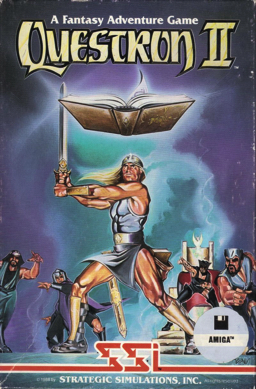
The Bard's Tale is a fantasy role-playing video game designed and programmed by Michael Cranford for the Apple II. It was produced by Interplay Productions in 1985 and distributed by Electronic Arts. The game was ported to the Commodore 64, Apple IIGS, ZX Spectrum, Amstrad CPC, Amiga, Atari ST, DOS, Macintosh, and NES. It spawned The Bard's Tale series of games and books. The earliest editions of the game used a series title of Tales of the Unknown, but this title was dropped for later ports of The Bard's Tale and subsequent games in the series.

Road Runner is a racing video game based on the Wile E. Coyote and Road Runner shorts. It was released in arcades by Atari Games in 1985.

Wizard's Crown is a 1986 top-down role-playing video game published by Strategic Simulations. It was released for the Atari 8-bit, Atari ST, IBM PC compatibles, Apple II, and Commodore 64. A sequel, The Eternal Dagger, was released in 1987.

Autoduel is a role-playing video game published by Origin Systems for the Atari 8-bit family, Commodore 64, Apple II, and IBM PC compatibles in 1985. It was released in 1987 for the Atari ST and in 1988 for the Amiga and Macintosh. The game is based on the Steve Jackson Games series Car Wars.

Roadwar 2000 is a 1986 video game published by Strategic Simulations, Inc. It is a turn-based strategy game set in a post-apocalyptic future which resembles the world portrayed in the Mad Max films.

The Pawn is an interactive fiction game for the Sinclair QL written by Rob Steggles of Magnetic Scrolls and published by Sinclair Research in 1985. In 1986, graphics were added and the game was released for additional home computers by Rainbird.

The Summoning is an isometric-view fantasy role-playing video game developed by Event Horizon Software and published by Strategic Simulations in 1992.

Wizardry: Proving Grounds of the Mad Overlord is the first game in the Wizardry series of role-playing video games. It was developed by Andrew Greenberg and Robert Woodhead. In 1980, Norman Sirotek formed Sir-Tech Software, Inc. and launched a beta version of the product at the 1980 Boston Computer Convention. The final version of the game was released in 1981.

Tass Times in Tonetown is an adventure game published by Activision in 1986. It was designed by Michael Berlyn and Muffy McClung Berlyn and programmed by Rebecca Heineman of Interplay in cooperation with Brainwave Creations.

The Movie Monster Game is a computer game released by Epyx for the Apple II and Commodore 64 in 1986. The game offers a variety of scenarios, playable monsters, and cities to demolish. The monsters are based on popular movie monsters such as The Blob, Mothra, the Stay Puft Marshmallow Man, and the Transformers, and Epyx was able to officially license Godzilla.

Time Bandit is a maze shoot 'em up written for the TRS-80 Model I by Bill Dunlevy and Harry Lafnear and published by MichTron in 1983. It was ported to the TRS-80 Color Computer and Dragon 32, but enjoyed its greatest popularity several years later as an early release for the Atari ST. It was also released for the pseudo-PC-compatible Sanyo MBC-55x with 8-color display. Amiga and MS-DOS versions were ported by Timothy Purves.
Mission: Thunderbolt is a roguelike computer game developed in 1986 commercially released in 1992. Developed by Dave Scheifler for Digital Equipment Corporation mainframe computers, it was later released as Doomsday 2000 on Mac OS and Windows.

Shanghai is a computerized version of mahjong solitaire published by Activision in 1986 for the Amiga, Atari ST, Atari 8-bit family, Commodore 64, DOS, Macintosh, Apple IIGS and Master System. Shanghai was originally programmed by Brodie Lockard. It was released as an arcade game by Sunsoft in 1988.

Questron II a 1988 role-playing video game published by Strategic Simulations for the Apple II, Apple IIGS, Atari ST, Commodore 64, IBM PC, and Amiga. It is the sequel to 1984's Questron. The story and original design is credited to Quest Software, the programming and artwork is credited to Westwood Associates.

Temple of Apshai Trilogy is a remake of three games from the Dunjonquest series, Temple of Apshai, Upper Reaches of Apshai, and Curse of Ra.

Empire: Wargame of the Century is a video game based on Empire developed by Walter Bright and published by Interstel Corporation in 1987.

Macadam Bumper is a video pinball simulation construction set developed by ERE Informatique in France. It was first released for 8-bit computers in 1985, the Atari ST in 1986 and MS-DOS in 1987. The Atari ST and MS-DOS versions were released in the US as Pinball Wizard in 1988 by Accolade.

Championship Baseball is a sports video game developed by Activision's Gamestar division in 1986.

Indoor Sports is a sports video game developed by DesignStar's SportTime and first published in the U.S. by Mindscape in 1987 for the Commodore 64. Indoor Sports includes simulations of bowling, darts, ping-pong, and air hockey. It was converted to the Acorn Electron, Amiga, Amstrad CPC, Apple II, Atari ST, BBC Micro, MS-DOS, and ZX Spectrum. Verisons for the Commodore 16 and Commodore Plus/4 omit Air Hockey. In Europe it was published by Databyte, Advance Software, and Tynesoft, depending on the platform.

Phantasie is the first video game in the Phantasie series.



















